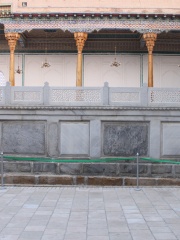




The Most Famous
RELIGIOUS FIGURES from Uzbekistan
This page contains a list of the greatest Uzbekistani Religious Figures. The pantheon dataset contains 3,187 Religious Figures, 6 of which were born in Uzbekistan. This makes Uzbekistan the birth place of the 51st most number of Religious Figures behind Vietnam, and Denmark.
Top 6
The following people are considered by Pantheon to be the most legendary Uzbekistani Religious Figures of all time. This list of famous Uzbekistani Religious Figures is sorted by HPI (Historical Popularity Index), a metric that aggregates information on a biography's online popularity.

1. Muhammad al-Bukhari (810 - 870)
With an HPI of 83.91, Muhammad al-Bukhari is the most famous Uzbekistani Religious Figure. His biography has been translated into 75 different languages on wikipedia.
Abū ʿAbd Allāh Muḥammad ibn Ismāʿīl ibn Ibrāhīm al-Juʿfī al-Bukhārī (Arabic: أبو عبد الله محمد بن إسماعيل بن إبرهيم الجعفي البخاري; 21 July 810 – 1 September 870) was a 9th-century Muslim muhaddith who is widely regarded as the most important hadith scholar in the history of Sunni Islam. Al-Bukhari's extant works include the hadith collection Sahih al-Bukhari, al-Tarikh al-Kabir, and al-Adab al-Mufrad. Born in Bukhara in present-day Uzbekistan, Al-Bukhari began learning hadith at a young age. He travelled across the Abbasid Caliphate and learned under several influential contemporary scholars. Bukhari memorized thousands of hadith narrations, compiling the Sahih al-Bukhari in 846. He spent the rest of his life teaching the hadith he had collected. Towards the end of his life, he was exiled from Nishapur. Subsequently, he moved to Khartank, near Samarkand. Sahih al-Bukhari is revered as the most important hadith collection in Sunni Islam. Sahih al-Bukhari and Sahih Muslim, the hadith collection of Al-Bukhari's student Muslim ibn al-Hajjaj, are together known as the Sahihayn (Arabic: صحيحين, romanized: Saḥiḥayn) and are regarded by Sunnis as the most authentic books after the Quran. It is part of the Kutub al-Sittah, the six most highly regarded collections of hadith in Sunni Islam.

2. Al-Tirmidhi (824 - 892)
With an HPI of 76.62, Al-Tirmidhi is the 2nd most famous Uzbekistani Religious Figure. His biography has been translated into 46 different languages.
Muhammad ibn Isa al-Tirmidhi (Arabic: محمد بن عيسى الترمذي, romanized: Muḥammad ibn ʿĪsā at-Tirmidhī; 824 – 9 October 892 CE / 209–279 AH), often referred to as Imām at-Termezī/Tirmidhī, was an Islamic scholar, and collector of hadith from Termez (early Khorasan and in present-day Uzbekistan). He wrote al-Jami` as-Sahih (known as Jami` at-Tirmidhi), one of the six canonical hadith compilations in Sunni Islam. He also wrote Shama'il Muhammadiyah (popularly known as Shama'il at-Tirmidhi), a compilation of hadiths concerning the person and character of the Islamic prophet, Muhammad. At-Tirmidhi was also well versed in Arabic grammar, favoring the school of Kufa over Basra due to the former's preservation of Arabic poetry as a primary source.

3. Abu Mansur al-Maturidi (893 - 944)
With an HPI of 73.12, Abu Mansur al-Maturidi is the 3rd most famous Uzbekistani Religious Figure. His biography has been translated into 31 different languages.
Imam Abu Mansur al-Maturidi (Arabic: أبو منصور الماتريدي, romanized: Abū Manṣūr al-Māturīdī; 853–944) was a Hanafi jurist and theologian who is the eponym of the Maturidi school of kalam in Sunnism. He got his nisba from Māturīd, a district in Samarkand. His works include Tafsir al-Maturidi, a classic exegesis of the Qur'an, and Kitab al-Tawhid. His doctrinal school remains amongst the three main schools of theology alongside Ash'arism and Atharism.

4. Baha-ud-Din Naqshband Bukhari (1327 - 1390)
With an HPI of 73.10, Baha-ud-Din Naqshband Bukhari is the 4th most famous Uzbekistani Religious Figure. His biography has been translated into 27 different languages.
Baha' al-Din Naqshband (Persian: بهاءالدین محمد نقشبند; 1318–1389) was the eponymous founder of what became one of the largest Sufi Sunni orders, the Naqshbandi.

5. Ad-Darazi (1000 - 1018)
With an HPI of 63.94, Ad-Darazi is the 5th most famous Uzbekistani Religious Figure. His biography has been translated into 17 different languages.
Muhammad ibn Isma'il al-Darazi (Arabic: محمد بن إسماعيل الدرزي, romanized: Muḥammad ibn Ismāʿīl al-Darazī; died 1018) was an 11th-century Isma'ili preacher and early leader of the Druze faith who was labeled a heretic in 1016 and subsequently executed in 1018 by the Fatimid caliph al-Hakim bi-Amr Allah (r. 996–1021).

6. Amoghavajra (705 - 774)
With an HPI of 62.70, Amoghavajra is the 6th most famous Uzbekistani Religious Figure. His biography has been translated into 18 different languages.
Amoghavajra (Sanskrit: अमोघवज्र Amoghavajra; Chinese: 不空; pinyin: Bùkōng; Japanese: Fukū; Korean: 불공; Vietnamese: Bất Không, 705–774) was a prolific translator who became one of the most politically powerful Buddhist monks in Chinese history and is acknowledged as one of the Patriarchs of Zhenyan Buddhism and Shingon Buddhism.
People
Pantheon has 6 people classified as Uzbekistani religious figures born between 705 and 1327. Of these 6, none of them are still alive today. The most famous deceased Uzbekistani religious figures include Muhammad al-Bukhari, Al-Tirmidhi, and Abu Mansur al-Maturidi.
Deceased Uzbekistani Religious Figures
Go to all RankingsMuhammad al-Bukhari
810 - 870
HPI: 83.91
Al-Tirmidhi
824 - 892
HPI: 76.62
Abu Mansur al-Maturidi
893 - 944
HPI: 73.12
Baha-ud-Din Naqshband Bukhari
1327 - 1390
HPI: 73.10
Ad-Darazi
1000 - 1018
HPI: 63.94
Amoghavajra
705 - 774
HPI: 62.70

